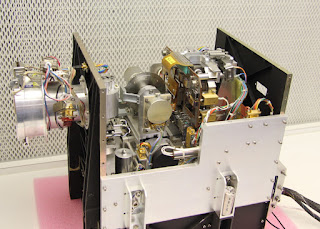 |
| Image Source: Washingtonian |
Topics: African Americans, Diaspora, Diversity, History, STEM
As a parent, I exposed my sons to our culture and history through books like "Selected Poems by Langston Hughes"; "Complete Poems by Langston Hughes"; "Invisible Man" by Ralph Ellison; "Native Son" by Richard Wright. I also exposed them to books about black inventors, since I made most of my income in a STEM field.
Today is my oldest son's 34th birthday. Tomorrow, the National Museum of African American History and Culture opens. I gave a generous donation on the one day giving last Wednesday September 14th, a day before what would have been my mother's 91st birthday were she still alive. It was also to honor her memory.
I grew up in a de jure segregated neighborhood in Winston-Salem, North Carolina. I usually open a conversation with someone of strong political views and negative stereotypes: "Have you ever met someone from a ghetto?" They are usually surprised to hear they've been talking to someone born into one. The home my parents owned was due to the laws at the time, legislating where a segment of society lived, even where I was born: Kate Bitting Hospital, at the time was one of 12 hospitals exclusively for African Americans. My kindergarten - Bethlehem Community Center - was specifically named by the Methodist Ministries as a designation of location: Bethlehem Community Centers were on "our" side of town; Wesley Community Centers on the west, whiter side, both have integrated over time. I didn't have a computer (no one did), but my parents purchased The Encyclopedia Britannica, a chemistry set, a microscope, a telescope, an electronics kit, tools and comics. I was as thrilled by educational shows like "The Undersea World of Jacques Cousteau" as I was by Star Trek. I had excellent teachers that supplemented our out-of-date books with copies they xeroxed at their own cost. Both they and my parents were supporting all of us in a society designed to not give the proper resources for my friends and I to succeed. It had its moments, but it wasn't the dystopian nightmare some orange political figures have recently labeled it.
I lament the crisis going on in Charlotte, North Carolina. The seeds of this bitter outrage were sown with Klan activities both repelled and lethal; threats and crosses burned when certain families left "their place"; redlining as I alluded to in my parents' case and the shooting of yet another Scott: Walter in South Carolina, Keith in North Carolina. As is now customary in such crises, the dead's previous sins are brought forward by the media, and used to justify their public execution. It is ironic that Walter had a weapon dropped next to his body; Keith was murdered (if it was a gun, and not a book) ironically, by a black policeman in an open carry state.
We have sojourned in this land since 1619. Benjamin Banneker laid the design and foundations of our nation's capital. Slaves built the Executive Mansion. Norbert Rillieux, Benjamin Montgomery, Elijah McCoy, Lewis Howard Latimer, Andrew Jackson Beard, Jan Earnest Matzeliger, Daniel Hale Williams, M.D., Granville T. Woods, George Washington Carve, Madame C. J. Walker, Garrett Augustus Morgan, Ernest Everett Just, PhD; Frederick McKinley Jones, David Nelson Crosthwait, Jr., Percy Lavon Julian, PhD, Charles Richard Drew, M.D., Claude Harvard, Jane Cook Wright, M.D., Meredith Gourdine, M.D., Michael Croslin, PhD, Earl D. Shaw, PhD, John P. Moon, George E. Carruthers, PhD, Shirley Ann Jackson, PhD: all in the book "Black Stars: African American Inventors" by Otha Richard Sullivan and Jim Haskins. I hope they are ALL in the museum, a dream and life's mission of Congressman John Lewis. There are too many negative stereotypes constantly reinforced by an entertainment complex dominated by the European culture with citizens that typically don't live near African Americans and to this day, de facto self-segregate economically through opportunities and resources allocated in political fiat. It is the very reason ALL elections are important.
Also I hope, along with inventors, the one man that broke a 232-year hegemony of white male rule. 100% efficiency is anathema in Thermodynamics, as it implies something that cannot exist: a perpetual motion machine. Barack Hussein Obama has been vilified because of his name, because of his complexion, because of his intellect, because of his preparation; because of his effectiveness. A meeting was held the night of his inauguration to oppose ANYTHING he proposed, even if they had previously been for it. He was forced to show his long form birth certificate by the current front runner who wasn't satisfied and doubted it publicly for four years until last Friday in a faux news conference/hotel infomercial. He is the only chief executive that was disrespected during a State of the Union (Joe Wilson - R-SC) "you LIE." He's had records set on the number of filibusters filed against his legislation. He has brokered the Paris Climate accords. He is arguably our most effective president, but for the not-too-subtle subtext of America that predates him, a sour milk of rage nursed from the end of the Civil War to the present. He is both the culmination of what's possible in America and a public indictment to its hypocrisy. Hopefully, that door of 2.3% "Other" will be expanded to 4.4% as another wall; another glass ceiling crumbles. Change is a part of life. That is the change that will make us an even better nation than callously stoked fears.
America could not be America without our input. Every movement: Women's Suffrage; Women's Rights; LGBT and Human Rights have patterned themselves after our straightened backs did not bend. Our backs are further braced by the demonstrators in Charlotte exercising their First Amendment Rights, and my fraternity brother Colin Kaepernick kneeling during the National Anthem to express his.
This is a journey we've made and continue to make for a better nation. We should be proud of it, and ourselves.














